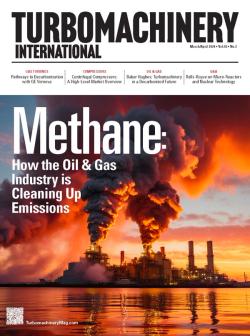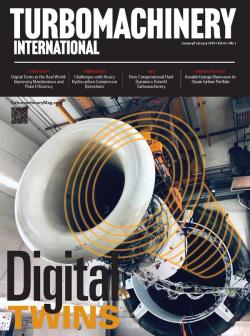
OR WAIT null SECS
© 2024 MJH Life Sciences™ and Turbomachinery Magazine. All rights reserved.
CHALLENGES FOR TURBOCOMPRESSORS
Higher reliability and availability are primary requisites of turbomachinery operations teams. Modern turbocompressors, after all, are often designed to be operated unmanned with minimum support from operations and maintenance teams. Extensive involvement might be required during planned shutdowns or overhauls. However, the general expectation is that turbocompressors should run for years without unscheduled shutdown or repair.
Operations teams require flexibility. For example, a wider range of variable speed for turbocompressors is almost always requested. The plant should be flexible enough to continue to run even if one operating parameter is changed or if there is an issue with one piece of equipment.
Seals and bearings
Dry gas seal problems are major causes of concern. Alternatives such as oil seals are challenging and often impractical. The current focus is on superior dry gas seal systems or the elimination of seals altogether as in the “sealless compressor.”
Alternative bearing systems, particularly magnetic bearings, aim to eliminate physical contact. Magnetic bearings can offer less energy waste, eliminate friction, and associated energy losses and wear. In addition, they introduce superior reliability and availability, as well as having built-in condition monitoring and control capabilities. Many believe this is the future of bearing technology in turbomachinery.
Other bearing options, such as air bearing (foil bearings) and water bearings (which use water instead of lubrication oil) have been introduced for small compressors. However, this field needs more research before it will see wider application.
Operations teams want turbomachinery suppliers to reduce the number of trips, and offer better alarm management and integrated condition monitoring. The overall trend is toward eliminating trips and introducing alarms for well-coordinated shutdowns. In this way, a special alarm will be issued with some suggestions for shutdown in a defined time period.
Connected to this trend is the reduction of alarms and a simplification of alarm management. This cannot be implemented for some critical trip cases, such as lubrication oil supply, as bearings can be damaged within a few seconds. However, it might be introduced for many other trips, such as those related to seal systems.
When it comes to better alarm management, unimportant or annoying alarms should be the first to be deleted. And integrated condition monitoring is becoming a must as the knowledge of typical operators concerning turbomachinery problems can sometimes be relatively low.
Modern turbocompressors are complicated pieces of equipment, and only machinery specialists or vendor representatives know them well. Thus an integrated monitoring, control and operations system can be of great assistance. For example, the restart of a compressor after a trip has caused problems, confusion and even damage in some instances.
The minimum number of necessary trips should be clearly defined, and turbomachinery trips due to minor situations should be avoided. Proper onsite checks should be suggested by condition monitoring and machinery interface systems to guide the operations team. Vendors are often focused on contractual requirements, such as guaranteed performance efficiency and trouble- free operation during the guarantee period.
Vendor concern over trips is concentrated mainly on component damage and serious events. It is often the case that alarm and trip points are set too conservatively to protect vendors. But not enough care is sometimes taken regarding optimum operation and the eradication of unnecessary trips, downtime or plant shutdowns.
Condition monitoring systems supplied by a sub-contractor or an independent vendor can introduce differing views on operations, reliability and priorities. Modular turbomachinery package design is also important. The assembly of all components into a large module with a weight of 800 tons or more necessitates costly delivery arrangements and special cranes for installation. This is where optimum skid design comes in.
The whole turbomachinery package should be divided into a minimum number of packaged and assembled skids (modules). This can offer minimum overall cost, and ease of installation, completion and commissioning. Each skid can be assembled, completed and pre-commissioned at a vendor shop. Each module should be within defined weight and dimension limits to allow easy delivery and installation. Inter-connecting piping and other connections should be optimized.
Large turbocompressor packages can be delivered with four skids: Turbocompressor casings and seal panels; the fully assembled and packaged driver; the lubrication oil system and auxiliaries; and the coolers. These four skids should be supported with prefabricated piping connections.
Plant architectures are changing. Many modern turbocompressors use direct-drive Variable Speed Drive (VSD) electric motors or direct-drive, variable-speed aeroderivative gas turbines. Another promising concept is a hermitically sealed compressor with a high-speed, variable-speed electric motor directly coupled to a centrifugal compressor casing. This machine uses magnetic bearings and can eliminate the dry gas seal and the lubrication oil system.
Theoretically, such a compressor package can offer five or more years of continuous operation without shutdown.
Project delays
Installation and commissioning delays are commonplace. Foundation issues are often to blame. One possible solution is closer control of the engineering, design and implementation loop for turbomachinery and the foundation. The turbomachinery package design should be finished in time to allow proper preparation of the foundation and associated civil details.
OEMs should be held accountable on this point. In that way, the foundation can be completed before turbomachinery arrives at the site. Issues between the purchaser and the vendor must be settled before finalization of turbomachinery layout.
Beware of two areas of potential bottleneck: Late delivery of the turbomachinery layout and unavailability of civil engineers in the purchasing team.



